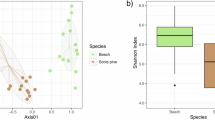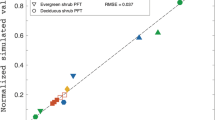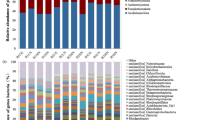Abstract
It was hypothesized that seasonality and resource availability altered through tree girdling were major determinants of the phylogenetic composition of the archaeal and bacterial community in a temperate beech forest soil. During a 2-year field experiment, involving girdling of beech trees to intercept the transfer of easily available carbon (C) from the canopy to roots, members of the dominant phylogenetic microbial phyla residing in top soils under girdled versus untreated control trees were monitored at bimonthly intervals through 16S rRNA gene-based terminal restriction fragment length polymorphism profiling and quantitative PCR analysis. Effects on nitrifying and denitrifying groups were assessed by measuring the abundances of nirS and nosZ genes as well as bacterial and archaeal amoA genes. Seasonal dynamics displayed by key phylogenetic and nitrogen (N) cycling functional groups were found to be tightly coupled with seasonal alterations in labile C and N pools as well as with variation in soil temperature and soil moisture. In particular, archaea and acidobacteria were highly responsive to soil nutritional and soil climatic changes associated with seasonality, indicating their high metabolic versatility and capability to adapt to environmental changes. For these phyla, significant interrelations with soil chemical and microbial process data were found suggesting their potential, but poorly described contribution to nitrification or denitrification in temperate forest soils. In conclusion, our extensive approach allowed us to get novel insights into effects of seasonality and resource availability on the microbial community, in particular on hitherto poorly studied bacterial phyla and functional groups.
Similar content being viewed by others
Log in or create a free account to read this content
Gain free access to this article, as well as selected content from this journal and more on nature.com
or
References
Adair KL, Schwartz E . (2008). Evidence that ammonia-oxidizing archaea are more abundant than ammonia-oxidizing bacteria in semiarid soils of northern Arizona, USA. Microbial Ecol 56: 420–426.
Alden L, Demoling F, Bååth E . (2001). Rapid method of determining factors limiting bacterial growth in soil. Appl Environ Microbiol 67: 1830–1838.
Bartossek R, Nicol GW, Lanzen A, Klenk H-P, Schleper C . (2010). Homologues of nitrite reductases in ammonia-ozidizing archaea: diversity and genomic context. FEMS Environ Microbiol 12: 1075–1088.
Barns SM, Takala SL, Kuske CR . (1999). Wide distribution and diversity of members of the bacterial kingdom Acidobacterium in the environment. Appl Environ Microbiol 65: 1731–1737.
Bell CW, Acosta-Martinez V, McIntyre NE, Cox S, Tissue DT, Zak JC . (2009). Linking microbial community structure function to seasonal differences in soil moisture temperature in a Chihuahuan Desert grassland. Microbial Ecol (in press; doi:10.1007/s00248-009-9529-5).
Brierley EDR, Wood M, Shaw PJA . (2001). Nitrogen cycling and proton fluxes in an acid forest soil. Plant Soil 229: 83–96.
Buckley DH, Schmidt TM . (2002). Exploring the biodiversity of soil: a microbial rainforest. Biodiversity of Microbial Life, In: Staley, JT and Reysenbach, AL (eds). Wiley-Liss: New York, NY, pp 183–208.
Cabello P, Roldán MD, Moreno-Vivían C . (2004). Nitrate reduction and the nitrogen cycle in archaea. Microbiology 150: 3527–3546.
Caffrey JM, Bano N, Kalanetra K, Hollibaugh JT . (2007). Ammonia oxidation and ammonia-oxidizing bacteria and archaea from estuaries with differing histories of hypoxia. The ISME J 1: 660–662.
Cannell MGR, Dewar RC . (1994). Carbon allocation in trees: a review of concepts for modelling. Adv Ecol Res 25: 59–104.
Chen XP, Zhu YG, Xia Y, Shen JP, He JZ . (2008). Ammonia-oxidizing archaea: important players in paddy rhizosphere soil? Environ Microbiol 10: 1978–1987.
Clarke KR, Green RH . (1988). Statistical design and analysis for a ‘biological effects’ study. Mar Ecol Prog Ser 46: 213–226.
Cleveland CC, Nemergut DR, Schmidt SK, Townsend AR . (2007). Increases in soil respiration following labile carbon additions linked to rapid shifts in soil microbial community composition. Biogeochemistry 82: 229–240.
Cookson WR, Marschner P, Clark IM, Milton N, Smirk MN, Murphy DV et al. (2006). The influence of season, agricultural management, and soil properties on gross nitrogen transformations and bacterial community structure. Aust J Soil Res 44: 453–465.
Cruz-Martínez K, Suttle KB, Brodie EL, Power ME, Andersen GL, Banfield JF . (2009). Despite strong seasonal responses, soil microbial consortia are more resilient to long-term changes in rainfall than overlying grassland. ISME J 3: 738–744.
Dannenmann M, Simon J, Gasche R, Holst J, Naumann PS, Koegel-Knabner I et al. (2009). Tree girdling provides insight on the role of labile carbon in nitrogen partitioning between soil microorganisms and adult European beech. Soil Biol Biochem 41: 1622–1631.
Drenovsky RE, Vo D, Graham KJ, Scow KM . (2004). Soil water content and organic carbon availability are major determinants of soil microbial community composition. Microbial Ecol 48: 424–430.
Dunbar J, Ticknor LO, Kuske CR . (2000). Assessment of microbial diversity in four Southwestern United States soils by 16S rRNA gene terminal restriction fragment analysis. Appl Environ Microbiol 66: 2943–2950.
Eichorst SA, Breznak JA, Schmidt TM . (2007). Isolation and characterization of soil bacteria that define Terriglobus gen. nov., in the phylum Acidobacteria. Appl Environ Microbiol 73: 2708–2717.
Ekberg A, Buchmann N, Gleixner G . (2007). Rhizospheric influence on soil respiration and decomposition in a temperate Norway spruce stand. Soil Biol Biochem 39: 2103–2110.
Fierer N, Bradford MA, Jackson RB . (2007). Toward an ecological classification of soil bacteria. Ecology 88: 1354–1364.
Fierer N, Carney KM, Horner-Devine MC, Megonigal JP . (2009). The biogeography of ammonia-oxidizing bacterial communities in soil. Microbial Ecol 58: 435–445.
Fontaine S, Bardoux G, Benest D, Verdier B, Mariotti A, Abbadie L . (2004). Mechanisms of the priming effect in a savannah soil amended with cellulose. Soil Sci Soc Am J 68: 125–131.
Francis CA, Roberts KJ, Beman JM, Santoro AE, Oakley BB . (2005). Ubiquity and diversity of ammonia-oxidizing archaea in water columns and sediments of the ocean. P Natl Acad Sci USA 102: 14683–14688.
Grayston SJ, Prescott CE . (2005). Microbial communities in forest floors under four tree species in coastal British Columbia. Soil Biol Biochem 37: 1157–1167.
Hackl E, Zechmeister-Boltenstern S, Bodrossy L, Sessitsch A . (2004). Comparison of diversities and compositions of bacterial populations inhabiting natural forest soils. Appl Environ Microbiol 70: 5057–5065.
Hansel CM, Fendorf S, Jardine PM, Francis CA . (2008). Changes in bacterial and archaeal community structure and functional diversity along a geochemically variable soil profile. Appl Environ Microbiol 74: 1620–1633.
Hayatsu M, Tago K, Saito M . (2008). Various players in the nitrogen cycle: diversity and functions of the microorganisms involved in nitrification and denitrification. Soil Sci Plant Nutr 54: 33–45.
He J, Shen J, Zhang L, Zhu Y, Zheng Y, Xu M et al. (2007). Quantitative analyses of the abundance and composition of ammonia-oxidizing bacteria and ammonia-oxidizing archaea of a Chinese upland red soil under long-term fertilization. Environ Microbiol 9: 2364–2374.
Henderson SL, Dandie CE, Patten CL, Zebarth BJ, Burton DL, Trevors JT et al. (2010). Changes in denitrifier abundance, denitrification gene mRNA levels, nitrous oxide emissions, and denitrification in anoxic soil microcosms amended with glucose and plant pesidues. Appl Environ Microbiol 76: 2155–2164.
Henry S, Bru D, Stres B, Hallet S, Philippot L . (2006). Quantitative detection of the nosZ gene, encoding nitrous oxide reductase, and comparison of the abundances of 16S rRNA, narG, nirK, and nosZ genes in soils. Appl Environ Microbiol 72: 5181–5189.
Högberg P, Nordgren A, Buchmannn N, Taylor AFS, Ekblad A, Högberg MN et al. (2001). Large-scale forest girdling shows that current photosynthesis drives soil respiration. Nature 411: 789–792.
Högberg MN, Chen Y, Högberg P . (2007). Gross nitrogen mineralisation and fungi-to-bacteria ratios are negatively correlated in boreal forests. Biol Fert Soils 44: 363–366.
Horz H-P, Barbook A, Field CB, Bohannan BJM . (2004). Ammonia-oxidizing bacteria respond to multifactorial global change. P Natl Acad Sci USA 101: 15136–15141.
Janssen PH . (2006). Identifying the dominant soil bacterial taxa in libraries of 16S rRNA and 16S rRNA genes. Appl Environ Microbiol 72: 1719–1728.
Jia Z, Conrad R . (2009). Bacteria rather than Archaea dominate microbial ammonia oxidation in an agricultural soil. Environ Microbiol 11: 1658–1671.
Jones R, Robeson MS, Lauber CL, Hamady M, Knight R, Fierer N . (2009). A comprehensive survey of soil acidobacterial diversity using pyrosequencing and clone library analyses. ISME J 3: 442–453.
Kaiser C, Koranda M, Kitzler B, Fuchslueger L, Schnecker J, Schweiger P et al. (2010). Belowground carbon allocation by trees drive seasonal pattern of extracellular enzyme activities by altering microbial community composition in a beech forest soil. New Phytologist 187: 843–858.
Koch O, Tscherko D, Kandeler E . (2007). Temperature sensitivity of microbial respiration, nitrogen mineralization, and potential soil enzyme activities in organic alpine soils. Global Biogeochem Cycles 21: GB4017.
Krave AS, Lin B, Braster M, Laverman AM, van Stralen NM, Roling WF et al. (2002). Stratification and seasonal stability of diverse bacterial communities in a Pinus merkusii (pine) forest soil in central Java, Indonesia. Environ Microbiol 4: 361–373.
Lane D . (1991). 16S/23S rRNA sequencing, In: Stackebrandt, A and Goodfellow, M (eds). Nucleic Acid Techniques Systematics. John Wiley: West Sussex, UK, pp 115–175.
Legendre P, Legendre L . (1998). Numerical Ecology 2nd edn. Elsevier: Amsterdam, The Netherlands.
Leininger S, Urich T, Schloter M, Schwark L, Qi J, Nicol GW et al. (2006). Archaea predominate among ammonia-oxidizing prokaryotes in soils. Nature 442: 806–809.
Lejon DPH, Chaussod R, Ranger J, Ranjard L . (2005). Microbial community structure and density under different tree species in an acid forest soil (Morvan, France). Microbial Ecol 50: 614–625.
Lepš J, Šmilauer P . (2003). Multivariate Analysis of Ecological Data using CANOCO. Cambridge University Press: Oxford, UK, pp 282.
Liu W-T, Marsh TL, Cheng H, Forney LJ . (1997). Characterization of microbial diversity by determining terminal restriction length polymorphisms of genes encoding 16S rRNA. Appl Environ Microbiol 63: 4516–4522.
Lueders T, Friedrich M . (2000). Archaeal population dynamics during sequential reduction processes in rice field soil. Appl Environ Microbiol 66: 2732–2742.
Magill AH, Aber JD . (2000). Dissolved organic carbon and nitrogen relationships in forest litter as affected by nitrogen deposition. Soil Biol Biochem 32: 603–613.
Michotey V, Méjean V, Bonin P . (2000). Comparison of methods for quantification of cytochrome cd1-denitrifying bacteria in environmental marine samples. Applied and Environmental Microbiology 66: 1564–1571.
Muyzer G, Dewaal EC, Uitterlinden AG . (1993). Profiling of complex microbial populations by denaturing gradient gel electrophoresis analysis of polymerase chain reaction-amplified genes coding for 16S rRNA. Appl Environ Microbiol 59: 695–700.
O′Farrell KA, Janssen PH . (1999). Detection of verrucomicrobia in a pasture soil by PCR-mediated amplification of 16S rRNA genes. Appl Environ Microbiol 65: 4280–4284.
Overmann J, Coolen MJL, Tuschak C . (1999). Specific detection of different phylogenetic groups of chemocline bacteria based on PCR and denaturing gradient gel electrophoresis of 16S rRNA gene fragments. Arch Microbiol 172: 83–94.
Philippot L, Kuffner M, Chèneby D, Depret G, Laguerre G, Martin-Laurent F . (2006). Genetic structure and activity of the nitrate-reducers community in the rhizosphere of different cultivars of maize. Plant Soil 287: 177–186.
Rasche F, Hödl V, Poll C, Kandeler E, Gerzabek MH, van Elsas JD et al. (2006). Rhizosphere bacteria affected by transgenic potatoes with antibacterial activities compared with the effects of soil, wild-type potatoes, vegetation stage and pathogen exposure. FEMS Microbiol Ecol 56: 219–235.
Rotthauwe J-H, Witzel K-P, Liesack W . (1997). The ammonia monooxygenase structural gene amoA as a functional marker: molecular fine-scale analysis of natural ammonia-oxidizing populations. Appl Environ Microbiol 63: 4704–4712.
Ruppel S, Torsvik V, Daae FL, vreås L, Rühlmann J . (2007). Nitrogen availability decreases prokaryotic diversity in sandy soils. Biol Fert Soils 43: 449–459.
Santoro AE, Francis CA, de Sieyes NR, Boehm AB . (2008). Shifts in the relative abundance of ammonia-oxidizing bacteria and archaea across physicochemical gradients in a subterranean estuary. Environ Microbiol 10: 1068–1079.
Schimel JP, Weintraub MN . (2003). The implications of exoenzyme activity on microbial carbon and nitrogen limitation in soil: a theoretical model. Soil Biol Biochem 35: 549–563.
Shen JP, Zhang LM, Zhou YB, Zhang JB, He JZ . (2008). Abundance and composition of ammonia-oxidizing bacteria and ammonia-oxidizing archaea communities of an alkaline sandy loam. Environ Microbiol 10: 1601–1611.
Stres B, Danevèiè T, Pal L, Mrkonjiæ M, Resman L, Leskovec S et al. (2008). Influence of temperature and soil water content on bacterial, archaeal and denitrifying microbial communities in drained fen grassland soil microcosms. FEMS Microbiol Ecol 66: 110–122.
Tabuchi H, Kato K, Nioh I . (2008). Season and soil management affect soil microbial communities estimated using phospholipid fatty acid analysis in a continuous cabbage (Brassica oleracea var. capitata) cropping system. Soil Sci Plant Nutr 54: 369–378.
Throbäck IN, Enwall K, Jarvis A, Hallin S . (2004). Reassessing PCR primers targeting nirS, nirK and nosZ genes for community surveys of denitrifying bacteria with DGGE. FEMS Microbiol Ecol 49: 401–417.
Tourna M, Freitag TE Nicol GW, Prosser JI . (2008). Growth, activity and temperature responses of ammonia-oxidizing archaea and bacteria in soil microcosms. Environ Microbiol 10: 1357–1364.
Urakawa H, Tajima Y, Numata Y, Tsuneda S . (2008). Low temperature decreases the phylogenetic diversity of ammonia-oxidizing archaea and bacteria in aquarium biofiltration systems. Appl Environ Microbiol 74: 894–900.
Valentine DL . (2007). Adaptations to energy stress dictate the ecology and evolution of the archaea. Nat Rev Microbiol 5: 316–323.
Waldrop MP, Firestone MK . (2006). Altered utilization patterns of young and old soil C by microorganisms caused by temperature shifts and N additions. Biogeochemistry 67: 235–248.
Ward NL, Challacombe JF, Janssen PH, Henrissat B, Coutinho PM, Wu M et al. (2009). Three genomes from the phylum Acidobacteria provide insight into the lifestyles of these microorganisms in soils. Appl Environ Microbiol 75: 2046–2056.
Waring RH, Running SW . (1998). Forest ecosystems: analysis at multiple scales, 2nd edn. Academic Press: San Diego, CA.
Weintraub MN, Scott-Denton LE, Schmidt SK, Monson RK . (2007). The effects of tree rhizodeposition on soil exoenzyme activity, dissolved organic carbon, and nutrient availability in a subalpine forest ecosystem. Oecologia 154: 327–338.
Weisburg WG, Barns SM, Pelletier DA, Lane DJ . (1991). 16S ribosomal DNA amplification for phylogenetic study. J Bacteriol 173: 697–703.
Wolsing M, Priemé A . (2004). Observation of high seasonal variation in community structure of denitrifying bacteria in arable soil receiving artificial fertilizer and cattle manure by determining T-RFLP of nir gene fragments. FEMS Microbiol Ecol 48: 261–271.
Yarwood SA, Myrold DD, Högberg MN . (2009). Termination of belowground C allocation by trees alters soil fungal and bacterial communities in a boreal forest. FEMS Microbiol Ecol 70: 151–162.
Youssef NH, Elshahed MS . (2009). Diversity rankings among bacterial lineages in soil. ISME J 3: 305–313.
You J, Das A, Dolan EM, Hu Z . (2009). Ammonia-oxidizing archaea involved in nitrogen removal. Water Res 43: 1801–1809.
Zak DR, Holmes WE, White DC, Peacock AD, Tilman D . (2003). Plant diversity, soil microbial communities, and ecosystem function: are there any links? Ecology 84: 2042–2050.
Zehr JP, Ward BB . (2002). Nitrogen cycling in the ocean: new perspectives on processes and paradigms. Appl Environ Microbiol 68: 1015–1024.
Acknowledgements
This study was financed by the Austrian Science Fund (FWF, Project number: P18495-B03). We thank Dr. Evelyn Hackl (AIT) for her valuable comments and suggestions on the manuscript.
Author information
Authors and Affiliations
Corresponding author
Ethics declarations
Competing interests
The authors declare no conflict of interest.
Additional information
Supplementary information accompanies the paper on The ISME Journal website
Supplementary information
Rights and permissions
About this article
Cite this article
Rasche, F., Knapp, D., Kaiser, C. et al. Seasonality and resource availability control bacterial and archaeal communities in soils of a temperate beech forest. ISME J 5, 389–402 (2011). https://doi.org/10.1038/ismej.2010.138
Received:
Revised:
Accepted:
Published:
Issue date:
DOI: https://doi.org/10.1038/ismej.2010.138
Keywords
This article is cited by
-
Nitrogen Addition Enhances Soil Nitrogen Mineralization Through an Increase in Mineralizable Organic Nitrogen and the Abundance of Functional Genes
Journal of Soil Science and Plant Nutrition (2024)
-
Drivers of organic carbon stocks in eutrophic lake sediments after reestablishment of submerged aquatic vegetation
Plant and Soil (2024)
-
Erosion and deposition significantly affect the microbial diversity, co-occurrence network, and multifunctionality in agricultural soils of Northeast China
Journal of Soils and Sediments (2024)
-
Changes in composition and function of soil microbial communities during secondary succession in oldfields on the Tibetan Plateau
Plant and Soil (2024)
-
Divergent responses of soil bacterial and fungal community structures and functional groups to secondary succession after rubber plantation abandonment
Plant and Soil (2023)



